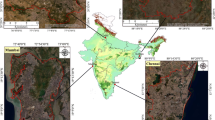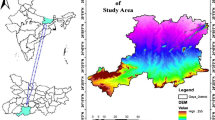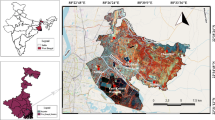Abstract
Spatial patterns of land surface temperature (LST), surface urban heat island (SUHI), surface urban cold island (SUCI), and their seasonal variations during January (winter) and September (summer) were analyzed over the three cities of Indian Punjab (Balachaur, Ludhiana and Bathinda) using Landsat 5, 7 and 8 satellite data of the years 1991, 2001, 2011, and 2018. Urban hot spots and Urban Thermal Field Variance Index (UTFVI) were used to measure the ecological environment of these cities. Land surface temperature was retrieved from Landsat satellite data using Plank equation, mono-window algorithm (MWA), single-channel algorithm (SCA), and radiative transfer equation. The LST derived using these algorithms was validated with MODIS-LST product. The relationship between LST derived from Landsat 5, 7 and 8 using the four methods and MODIS-LST product was higher with the SCA algorithm (R2 > 0.75). Land surface temperature was significantly positively correlated with built-up but significantly negatively correlated with vegetation. The surface urban heat intensity was higher during September than January, and it was higher in Ludhiana followed by Bathinda and Balachaur, irrespective of the season. Besides built-up area and population density, soil moisture availability in surrounding rural areas has significant impact on increasing surface urban heat intensity during September than January. The SUCIs were formed in the center of Bathinda city during January 1991, but these were in Ludhiana and Balachaur cities during January 2011. The most critical areas for ecological environment based on UTFVI were identified and the critical UTFVI values (> 0.020) were highest in Bathinda city followed by Balachaur and Ludhiana cities. These results suggest that SUHIs and SUCIs are influenced by seasons and the mitigating plans to counteract the overheating of urban areas should be formulated taking into account soil moisture availability in surrounding rural areas, landscape pattern, seasonal variations, local climatic conditions, urban growth, and development plan etc.








Similar content being viewed by others
References
Ahmed, S. (2018). Assessment of urban heat islands and impact of climate change on socioeconomic over Suez Governorate using remote sensing and GIS techniques. The Egyptian Journal of Remote Sensing and Space Science, 21(1), 15–25.
Akbari, H., Matthews, H. D., & Seto, D. (2012). The long-term effect of increasing the albedo of urban areas. Environmental Research Letters, 7(2), 024004.
Alipour, T., Sarajian, M., & Esmaeily, A. (2003). Land surface temperature estimation from thermal band of landsat sensor, case study: Alashtar city. The International Achieves of the Photogrammetry, Remote Sensing and Spatial Information Sciences, 38(4), 1–6.
Bentley, M. L., Sae-Jung, J., Kaminski, S., & Kesavawong, P. (2020). Documenting the evolution and expansion of surface urban heat in the Bangkok Metropolitan Region, 2000–2019. Asian Geographer, 37(2), 171–188.
Chakraborty, S. D., Kant, Y., & Mitra, D. (2015). Assessment of land surface temperature and heat fluxes over Delhi using remote sensing data. Journal of environmental management, 148, 143–152.
Dar, I., Qadir, J., & Shukla, A. (2019). Estimation of LST from multi-sensor thermal remote sensing data and evaluating the influence of sensor characteristics. Annals of GIS, 25(3), 263–281.
de Faria Peres, L., de Lucena, A. J., RotunnoFilho, O. C., & de Almeida França, J. R. (2018). The urban heat island in Rio de Janeiro, Brazil, in the last 30 years using remote sensing data. International Journal of Applied Earth Observation and Geoinformation, 64, 104–116.
Dialesandro, J. M., Wheeler, S. M., & Abunnasr, Y. (2019). Urban heat island behaviors in dryland regions. Environmental Research Communications, 1(8), 081005.
Foley, W. J., McIlwee, A., Lawler, I., Aragones, L., Woolnough, A. P., & Berding, N. (1998). Ecological applications of near infrared reflectance spectroscopy–a tool for rapid, cost-effective prediction of the composition of plant and animal tissues and aspects of animal performance. Oecologia, 116(3), 293–305.
García-Santos, V., Cuxart, J., Martínez-Villagrasa, D., Jiménez, M. A., & Simó, G. (2018). Comparison of three methods for estimating land surface temperature from landsat 8-tirs sensor data. Remote Sensing, 10(9), 1450.
Guha, S., Govil, H., & Mukherjee, S. (2017). Dynamic analysis and ecological evaluation of urban heat islands in Raipur city India. Journal of Applied Remote Sensing, 11(3), 036020.
Haeger-Eugensson, M., & Holmer, B. (1999). Advection caused by the urban heat island circulation as a regulating factor on the nocturnal urban heat island. International Journal of Climatology: A Journal of the Royal Meteorological Society, 19(9), 975–988.
Kingra, P., Setia, R., Kaur, J., Singh, S., Singh, S. P., Kukal, S., et al. (2018). Assessing the impact of climate variations on wheat yield in north-west India using GIS. Spatial Information Research, 26(3), 281–294.
Kumar, R., Mishra, V., Buzan, J., Kumar, R., Shindell, D., & Huber, M. (2017). Dominant control of agriculture and irrigation on urban heat island in India. Scientific reports, 7(1), 1–10.
Lakshmi, V., Czajkowski, K., Dubayah, R., & Susskind, J. (2001). Land surface air temperature mapping using TOVS and AVHRR. International Journal of Remote Sensing, 22(4), 643–662.
Laosuwan, T., & Sangpradit, S. (2012). Urban heat island monitoring and analysis by using integration of satellite data and knowledge based method. International Journal of Development and Sustainability, 1(2), 99–110.
Li, A., Xia, C., Bao, C., & Yin, G. (2019). Using MODIS land surface temperatures for permafrost thermal modeling in beiluhe basin on the Qinghai-Tibet Plateau. Sensors, 19(19), 4200.
Li, Z.-L., Tang, B.-H., Wu, H., Ren, H., Yan, G., Wan, Z., et al. (2013). Satellite-derived land surface temperature: Current status and perspectives. Remote sensing of environment, 131, 14–37.
Majumder, A., Kingra, P., Setia, R., Singh, S. P., & Pateriya, B. (2020). Influence of land use/land cover changes on surface temperature and its effect on crop yield in different agro-climatic regions of Indian Punjab. Geocarto International, 35(6), 663–686.
Masek, J. G., Vermote, E. F., Saleous, N. E., Wolfe, R., Hall, F. G., Huemmrich, K. F., et al. (2006). A Landsat surface reflectance dataset for North America, 1990–2000. IEEE Geoscience and Remote Sensing Letters, 3(1), 68–72.
Mathew, A., Khandelwal, S., & Kaul, N. (2016). Spatial and temporal variations of urban heat island effect and the effect of percentage impervious surface area and elevation on land surface temperature: Study of Chandigarh city, India. Sustainable Cities and Society, 26, 264–277.
Montazeri, M., & Masoodian, S. A. (2020). Tempo-spatial behavior of surface urban heat island of Isfahan Metropolitan Area. Journal of the Indian Society of Remote Sensing, 48(2), 263–270.
Mukherjee, S., Joshi, P., & Garg, R. (2017). Analysis of urban built-up areas and surface urban heat island using downscaled MODIS derived land surface temperature data. Geocarto International, 32(8), 900–918.
Ndossi, M. I., & Avdan, U. (2016a). Application of open source coding technologies in the production of land surface temperature (LST) maps from Landsat: A PyQGIS plugin. Remote Sensing, 8(5), 413.
Ndossi, M. I., & Avdan, U. (2016b). Inversion of land surface temperature (LST) using Terra ASTER data: A comparison of three algorithms. Remote Sensing, 8(12), 993.
Ningrum, W. (2018). Urban heat island towards urban climate. In: IOP Conference Series: Earth and Environmental Science , (Vols. 1, 118)
Pan, J. (2016). Area delineation and spatial-temporal dynamics of urban heat island in Lanzhou City, China using remote sensing imagery. Journal of the Indian Society of Remote Sensing, 44(1), 111–127.
Qin, Z., Karnieli, A., & Berliner, P. (2001). A mono-window algorithm for retrieving land surface temperature from Landsat TM data and its application to the Israel-Egypt border region. International Journal of Remote Sensing, 22(18), 3719–3746.
Rinner, C., & Hussain, M. (2011). Toronto’s urban heat island—Exploring the relationship between land use and surface temperature. Remote Sensing, 3(6), 1251–1265.
Sekertekin, A., & Bonafoni, S. (2020). Land surface temperature retrieval from Landsat 5, 7, and 8 over rural areas: Assessment of different retrieval algorithms and emissivity models and toolbox implementation. Remote Sensing, 12(2), 294.
Sobrino, J. A., Jiménez-Muñoz, J. C., Sòria, G., Romaguera, M., Guanter, L., Moreno, J., et al. (2008). Land surface emissivity retrieval from different VNIR and TIR sensors. IEEE Transactions on Geoscience and Remote Sensing, 46(2), 316–327.
Surawar, M., & Kotharkar, R. (2017). Assessment of urban heat island through remote sensing in Nagpur urban area using Landsat 7 ETM+ satellite images. International Journal of Urban and Civil Engineering, 11(7), 868–874.
Tripathi, S., & Mahey, K. (2017). Urbanization and economic growth in Punjab (India): An empirical analysis. Urban Research & Practice, 10(4), 379–402.
Tsou, J., Zhuang, J., Li, Y., & Zhang, Y. (2017). Urban heat island assessment using the Landsat 8 data: A case study in Shenzhen and Hong Kong. Urban Science, 1(1), 10.
Veeran, P., & Kumar, S. (1993). Analysis of monthly average daily global radiation and monthly average sunshine duration at two tropical locations. Renewable Energy, 3(8), 935–939.
Wang, S., He, L., & Hu, W. (2015). A temperature and emissivity separation algorithm for landsat-8 thermal infrared sensor data. Remote Sensing, 7(8), 9904–9927.
Wang, S., Xiang, M., He, Y., Tsou, J., Zhang, Y., San Liang, X., et al. (2018). Evaluating Urban heat island effects in rapidly developing coastal cities. In Coastal Environment, Disaster, and Infrastructure-A Case Study of China's Coastline: IntechOpen.
Weng, Q., Fu, P., & Gao, F. (2014). Generating daily land surface temperature at Landsat resolution by fusing Landsat and MODIS data. Remote sensing of environment, 145, 55–67.
Yang, L., Qian, F., Song, D.-X., & Zheng, K.-J. (2016). Research on urban heat-island effect. Procedia Engineering, 169, 11–18.
Yang, Q., Huang, X., & Li, J. (2017). Assessing the relationship between surface urban heat islands and landscape patterns across climatic zones in China. Scientific reports, 7(1), 1–11.
Yu, X., Guo, X., & Wu, Z. (2014). Land surface temperature retrieval from Landsat 8 TIRS—comparison between radiative transfer equation-based method, split window algorithm and single channel method. Remote Sensing, 6(10), 9829–9852.
Zhang, X., Friedl, M. A., Schaaf, C. B., Strahler, A. H., & Schneider, A. (2004). The footprint of urban climates on vegetation phenology. Geophysical Research Letters. https://doi.org/10.1029/2004GL020137
Zheng, Y., Ren, H., Guo, J., Ghent, D., Tansey, K., Hu, X., et al. (2019). Land surface temperature retrieval from sentinel-3A sea and land surface temperature radiometer, using a split-window algorithm. Remote Sensing, 11(6), 650.
Zhou, D., Zhao, S., Zhang, L., Sun, G., & Liu, Y. (2015). The footprint of urban heat island effect in China. Scientific reports, 5(1), 1–11.
Zhou, J., Li, J., Zhang, L., Hu, D., & Zhan, W. (2012). Intercomparison of methods for estimating land surface temperature from a Landsat-5 TM image in an arid region with low water vapour in the atmosphere. International Journal of Remote Sensing, 33(8), 2582–2602.
Author information
Authors and Affiliations
Corresponding author
Additional information
Publisher's Note
Springer Nature remains neutral with regard to jurisdictional claims in published maps and institutional affiliations.
Supplementary Information
Below is the link to the electronic supplementary material.
Rights and permissions
About this article
Cite this article
Majumder, A., Setia, R., Kingra, P.K. et al. Estimation of land surface temperature using different retrieval methods for studying the spatiotemporal variations of surface urban heat and cold islands in Indian Punjab. Environ Dev Sustain 23, 15921–15942 (2021). https://doi.org/10.1007/s10668-021-01321-3
Received:
Accepted:
Published:
Issue Date:
DOI: https://doi.org/10.1007/s10668-021-01321-3




